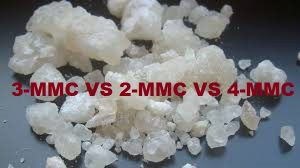Synthetic cathinones, commonly referred to as “bath salts,” are a class of psychoactive substances that have gained notoriety for their stimulant and empathogenic effects. Among these, 3-MMC (3-Methylmethcathinone), 2-MMC (2-Methylmethcathinone), and 4-MMC (4-Methylmethcathinone, also known as mephedrone) are three closely related compounds that share structural similarities but differ in their pharmacological effects, potency, and legal status. This article delves into the differences between these three substances, exploring their chemical structures, effects, risks, and legal implications.

Chemical Structure and Classification
At their core, 3-MMC, 2-MMC, and 4-MMC are all synthetic cathinones, which are derivatives of the naturally occurring stimulant cathinone found in the khat plant. The primary difference between these compounds lies in the position of the methyl group on the phenyl ring of the molecule:
- 4-MMC (Mephedrone): The methyl group is attached to the fourth carbon of the phenyl ring.
- 3-MMC (3-Methylmethcathinone): The methyl group is attached to the third carbon of the phenyl ring.
- 2-MMC (2-Methylmethcathinone): The methyl group is attached to the second carbon of the phenyl ring.
This slight variation in molecular structure significantly impacts how each compound interacts with the brain’s neurotransmitter systems, particularly dopamine, serotonin, and norepinephrine.
Pharmacological Effects
4-MMC (Mephedrone)
4-MMC, or mephedrone, is the most well-known and widely studied of the three. It gained popularity in the late 2000s as a legal alternative to MDMA and cocaine. Mephedrone primarily acts as a releasing agent of serotonin, dopamine, and norepinephrine, leading to effects such as:
- Euphoria
- Increased sociability and empathy
- Enhanced energy and alertness
- Heightened sensory perception
- Stimulation and reduced need for sleep
However, these effects are often accompanied by negative side effects, including anxiety, paranoia, teeth grinding, and vasoconstriction. The comedown from mephedrone can be particularly harsh, with users reporting depression, fatigue, and cravings.
3-MMC (3-Methylmethcathinone)
3-MMC is often described as a milder version of mephedrone, with a more balanced release of dopamine and serotonin. Its effects are similar but less intense, making it somewhat more manageable for users. Common effects include:
- Mild to moderate euphoria
- Increased talkativeness and sociability
- Moderate stimulation
- Enhanced mood and sensory perception
While 3-MMC is considered less potent than 4-MMC, it still carries risks, particularly with repeated use or high doses. Side effects may include increased heart rate, anxiety, and insomnia. For a more detailed exploration of the effects of 3-MMC, you can read this comprehensive guide on the effects of 3-MMC.
2-MMC (2-Methylmethcathinone)
2-MMC is the least studied of the three compounds, and anecdotal reports suggest it is the least potent. Its effects are primarily stimulant-like, with minimal empathogenic or entactogenic properties. Users report:
- Mild stimulation
- Increased focus and alertness
- Slight mood elevation
Due to its lower potency, 2-MMC is sometimes used as a functional stimulant rather than a recreational drug. However, it still poses risks, particularly when combined with other substances or taken in large quantities.
Potency and Duration
The potency and duration of effects vary significantly between these compounds:
- 4-MMC: Highly potent, with effects lasting 2-4 hours. The intense euphoria and rapid onset make it particularly addictive.
- 3-MMC: Moderately potent, with effects lasting 3-5 hours. The slower onset and milder effects make it less likely to cause severe comedowns. For more information on how long 3-MMC lasts, check out this detailed article on the duration of 3-MMC effects.
- 2-MMC: Least potent, with effects lasting 2-3 hours. Its mild stimulation makes it less appealing for recreational use but potentially more suitable for functional purposes.
Risks and Side Effects
All three compounds carry risks, particularly with frequent or high-dose use. These risks include:
- Cardiovascular issues: Increased heart rate, hypertension, and vasoconstriction.
- Neurotoxicity: Potential damage to serotonin and dopamine neurons, particularly with 4-MMC.
- Psychological effects: Anxiety, paranoia, and depression, especially during the comedown.
- Addiction potential: All three substances have the potential for psychological dependence, with 4-MMC being the most addictive.
Legal Status
The legal status of these compounds varies by country, but many nations have moved to control them due to their potential for abuse and harm:
- 4-MMC: Banned in most countries, including the UK, USA, and much of Europe.
- 3-MMC: Increasingly being controlled, with bans in several European countries. To understand the legal landscape of 3-MMC, you can refer to this in-depth analysis of the legality of 3-MMC.
- 2-MMC: Less commonly regulated but still subject to legal scrutiny in some regions.
Conclusion
While 3-MMC, 2-MMC, and 4-MMC share a common chemical backbone, their differences in molecular structure lead to distinct pharmacological profiles, effects, and risks. 4-MMC is the most potent and addictive, with strong empathogenic effects, while 3-MMC offers a milder alternative with a more balanced release of neurotransmitters. 2-MMC, on the other hand, is the least potent and primarily acts as a stimulant. Despite their differences, all three substances carry significant risks and are subject to increasing legal restrictions. As with any psychoactive substance, understanding these differences is crucial for making informed decisions and minimizing harm.
For further reading, you can explore user reviews of 3-MMC to gain insights into personal experiences, or learn about the optimal dosage for 3-MMC to ensure safer use. Additionally, if you’re interested in a direct comparison between 3-MMC and 4-MMC, this detailed comparison of 3-MMC vs. 4-MMC provides valuable insights.
